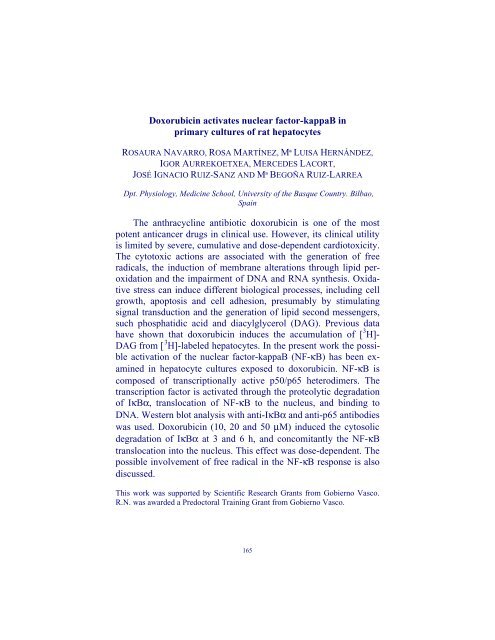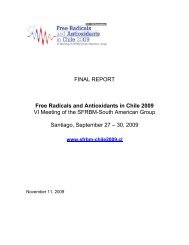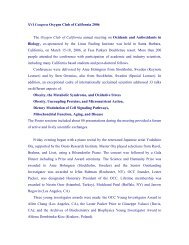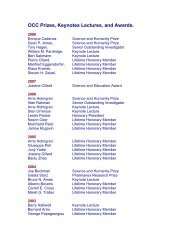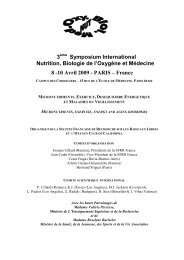oxidants and antioxidants in biology - Oxygen Club of California
oxidants and antioxidants in biology - Oxygen Club of California
oxidants and antioxidants in biology - Oxygen Club of California
Create successful ePaper yourself
Turn your PDF publications into a flip-book with our unique Google optimized e-Paper software.
Doxorubic<strong>in</strong> activates nuclear factor-kappaB <strong>in</strong><br />
primary cultures <strong>of</strong> rat hepatocytes<br />
ROSAURA NAVARRO, ROSA MARTÍNEZ, Mª LUISA HERNÁNDEZ,<br />
IGOR AURREKOETXEA, MERCEDES LACORT,<br />
JOSÉ IGNACIO RUIZ-SANZ AND Mª BEGOÑA RUIZ-LARREA<br />
Dpt. Physiology, Medic<strong>in</strong>e School, University <strong>of</strong> the Basque Country. Bilbao,<br />
Spa<strong>in</strong><br />
The anthracycl<strong>in</strong>e antibiotic doxorubic<strong>in</strong> is one <strong>of</strong> the most<br />
potent anticancer drugs <strong>in</strong> cl<strong>in</strong>ical use. However, its cl<strong>in</strong>ical utility<br />
is limited by severe, cumulative <strong>and</strong> dose-dependent cardiotoxicity.<br />
The cytotoxic actions are associated with the generation <strong>of</strong> free<br />
radicals, the <strong>in</strong>duction <strong>of</strong> membrane alterations through lipid peroxidation<br />
<strong>and</strong> the impairment <strong>of</strong> DNA <strong>and</strong> RNA synthesis. Oxidative<br />
stress can <strong>in</strong>duce different biological processes, <strong>in</strong>clud<strong>in</strong>g cell<br />
growth, apoptosis <strong>and</strong> cell adhesion, presumably by stimulat<strong>in</strong>g<br />
signal transduction <strong>and</strong> the generation <strong>of</strong> lipid second messengers,<br />
such phosphatidic acid <strong>and</strong> diacylglycerol (DAG). Previous data<br />
have shown that doxorubic<strong>in</strong> <strong>in</strong>duces the accumulation <strong>of</strong> [ 3 H]-<br />
DAG from [ 3 H]-labeled hepatocytes. In the present work the possible<br />
activation <strong>of</strong> the nuclear factor-kappaB (NF-κB) has been exam<strong>in</strong>ed<br />
<strong>in</strong> hepatocyte cultures exposed to doxorubic<strong>in</strong>. NF-κB is<br />
composed <strong>of</strong> transcriptionally active p50/p65 heterodimers. The<br />
transcription factor is activated through the proteolytic degradation<br />
<strong>of</strong> IκBα, translocation <strong>of</strong> NF-κB to the nucleus, <strong>and</strong> b<strong>in</strong>d<strong>in</strong>g to<br />
DNA. Western blot analysis with anti-IκBα <strong>and</strong> anti-p65 antibodies<br />
was used. Doxorubic<strong>in</strong> (10, 20 <strong>and</strong> 50 µM) <strong>in</strong>duced the cytosolic<br />
degradation <strong>of</strong> IκBα at 3 <strong>and</strong> 6 h, <strong>and</strong> concomitantly the NF-κB<br />
translocation <strong>in</strong>to the nucleus. This effect was dose-dependent. The<br />
possible <strong>in</strong>volvement <strong>of</strong> free radical <strong>in</strong> the NF-κB response is also<br />
discussed.<br />
This work was supported by Scientific Research Grants from Gobierno Vasco.<br />
R.N. was awarded a Predoctoral Tra<strong>in</strong><strong>in</strong>g Grant from Gobierno Vasco.<br />
165


